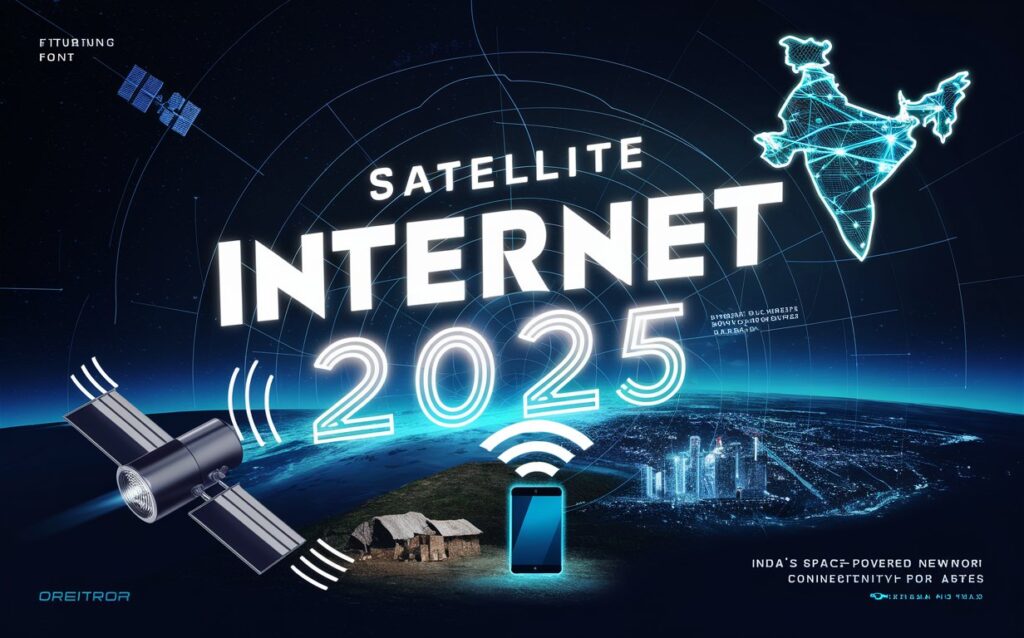🛰️ Satellite Internet 2025: How India Is Getting Connected From Space
India is entering a new digital age in 2025 powered by satellite internet. With vast rural populations still lacking reliable access to the web, space-based connectivity is proving to be the game-changer that traditional broadband couldn’t deliver. From education and healthcare to banking and e-commerce, satellite internet is driving India’s mission of true digital inclusion.

🚀 What Is Satellite Internet and Why It Matters
Satellite internet in India 2025 uses Low Earth Orbit (LEO) satellites to beam internet signals directly to ground-based terminals. Unlike fiber optics or mobile towers, this system doesn’t depend on cable infrastructure or dense networks, making it ideal for remote regions.
Major players like JioSpaceFiber, OneWeb (Bharti Group), Starlink by SpaceX, and Amazon’s Project Kuiper are racing to connect millions of Indians to high-speed internet — from the Himalayas to the Sundarbans.
📡 Rural Connectivity Revolution
Over 65% of India’s population lives in rural areas. Satellite internet is bringing high-speed access to villages in Rajasthan, Assam, Chhattisgarh, and Ladakh — places previously left in digital darkness.
In states like Jharkhand and Odisha, government schools are now running online smart classes via satellite internet. Doctors in remote clinics are using telemedicine apps to consult specialists in Delhi or Bengaluru — all thanks to this sky-based service.
💰 Affordable Plans and Government Push
The Indian government launched the Digital India Satellite Connect Policy 2025, offering subsidies on satellite terminal kits and reducing import duties for satellite tech companies.
With entry-level plans starting at just ₹399/month, companies like JioSpaceFiber are making satellite internet accessible to low-income families and small businesses.
🛰️ Key Benefits of Satellite Internet India 2025
- ⚡ Faster speeds than 4G in remote regions
- 🛠️ Quick deployment without digging or laying cables
- 🌎 Nationwide coverage, including islands and border areas
- 🧠 Smart learning, remote work, e-commerce access
- 🏥 Telemedicine, remote diagnostics, e-health services
🔐 Data Security and Reliability
Satellite internet providers in 2025 are using end-to-end encryption, AI-based network monitoring, and multi-satellite fallback systems to ensure uninterrupted, secure service.
Companies are also building ground control centers across India to reduce dependency on foreign tech and improve data sovereignty.
⚠️ Challenges Still Ahead
- 🌩️ Weather Disruption: Heavy rain or storms can affect signal clarity
- 🛰️ Initial Hardware Cost: Satellite dishes and routers still cost around ₹15,000
- 📵 Digital Literacy: Many rural users need training to use online services
To counter this, NGOs and startups are running free digital training camps in villages across India.
🔗 Linking India to the World
Satellite internet is allowing Indian entrepreneurs to start online stores, farmers to use real-time crop monitoring apps, and tribal communities to access e-governance portals.
External partners like UNESCO, WHO, and Google India have also joined hands to fund rural connectivity projects in 2025.
Internal portals like DigiLocker, PM-WANI, and eSanjeevani are seamlessly integrating with satellite networks for expanded outreach.
✅ Conclusion
Satellite internet in India 2025 is not just a tech trend — it’s a national transformation. From border villages to coastal towns, India is finally unlocking the power of the web for everyone, regardless of location. As satellites orbit above, India is rising below — smarter, faster, and more connected than ever. 🌐🇮🇳



Post Comment